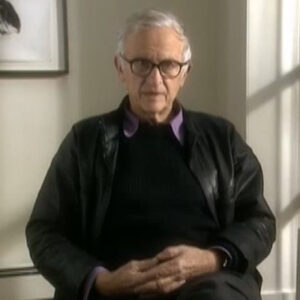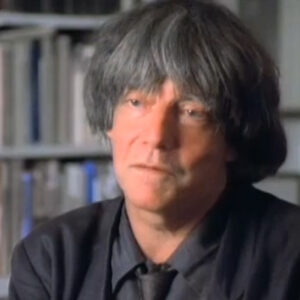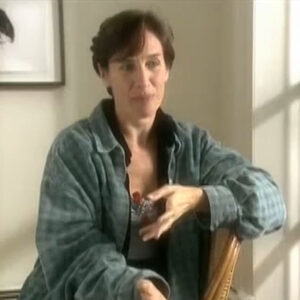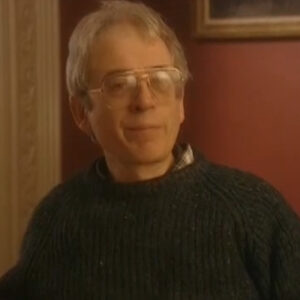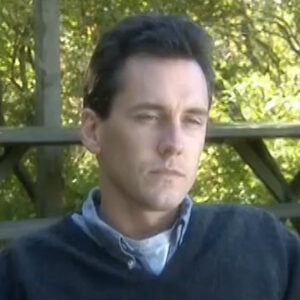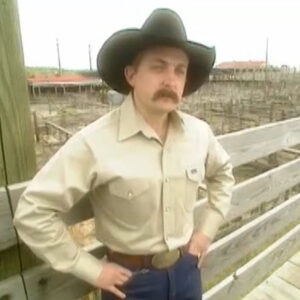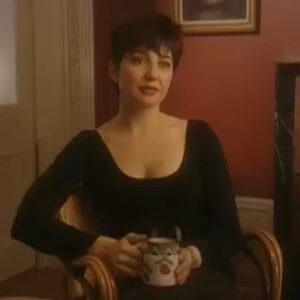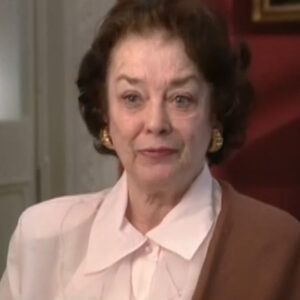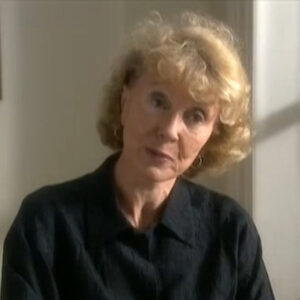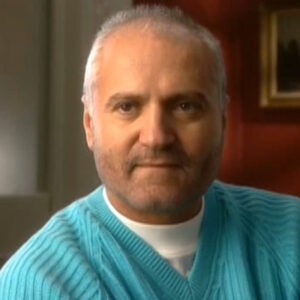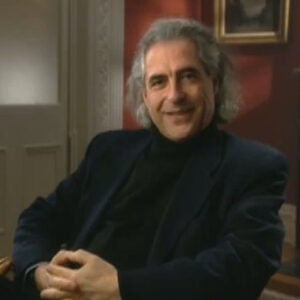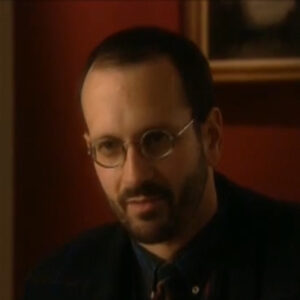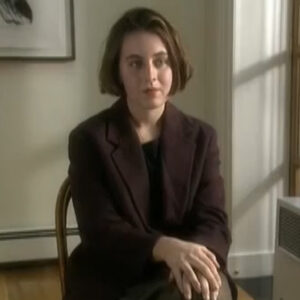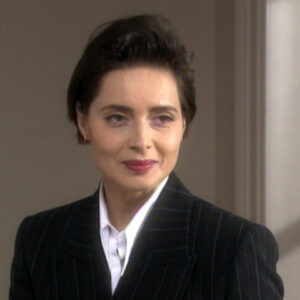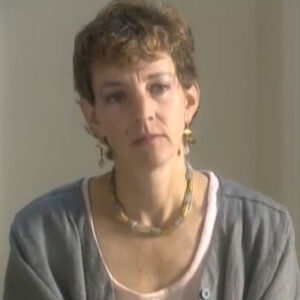Speaker Well, they say, I came to this country in 41 and the war started and Europe was cut off. So the great couture houses are finished. That was the great nourishment of fashion magazines and of photographers. So they emerged really an American fashion. And I remember Vogue came up with an issue, I think 41 or 42 USA fashion on its own.
Speaker And women had started collaborating in the war movement. They also worked in factories. I did not necessarily, but. So the the shishi style that had to be part of the luxury conception of fashion with feathers and ornaments and sculptures and all of that seem very dated.
Speaker And I had come from.
Speaker I saw a picture, magazine, news pictures, and one of the first things I tried to do was to modernize their approach to photography of women. I wanted a much more natural look, a believable lock up in a way I’ve always tried a dimmer Cratchit zation, a fashion and a present presentation of women. I’m interested in women and nothing close. And I showed to the photographers, even if they stay on the job. I think more house. And she was glorious. She was smiling and she was natural. So I tried to break artifice wherever I found it. And it was rather easy in those days because Vogue had a studio of its own and we had salaried photographers that we could more or less control. And. I believe the movement, but natural movement, not stylize. And you probably know the story. I think I saw a tiny little picture in Village Voice of something of sailors on Broadway, and it struck me as being very original. For some reason. So I asked who did this? And I was told other done. So I called Avatar. Now I have. He told me I just signed with Broadway at the bazaar. Now we find out that that was not true, that in any case, that’s what he told me. And I’ve always followed his work. Naturally, I looked at the bazaar and he’s an outstanding, unique, great photographer.
Speaker And later, when this Vreeland came to Vogue, I hired Avedon. I think at that time he was disenchanted with with the bazaar.
Speaker And we worked for. I’d say, what, 10 years old. But, you know, I can’t say I worked with Avatar the way I worked with Ben because Dick is his own master. And I’ve also he had a very special rapport with Diana Vreeland. So he would usually sort of doors get closed. And there were plus the sitting and the results would come in the three or four pictures. And I had been used to panel others who would send me all their contact sheets and I would pick 10, never picked a picture for years. So all the early pens, I think were my choices blindly trusted me, which Avedon did not. And he always said, well, you know, is Lieberman’s man and I’m proud of it. So I let him alone. I helped take some pictures. I supervised the layouts. And I thought he was a great addition to any magazine because every picture he does has a certain intensity, strengths and daring. And he likes to control. He would like to have a whole magazine. He always told me I wish I could do a whole issue. That is really his dream. Like, he, in a way would like to have it all and but which was impossible. Condé Nast. And I think he had done one issue, two issues at the bazaar with mom in Israel, I think. I’m not sure of all this, but so my encounter with him en vogue was very limited. I mean, okay, we chose the pictures with Vreeland and there was some remarkable covers and. And I think when Vreeland left, he again, I think left over for that.
Speaker I think he left because he started his Western project and he was difficult to get. It was not available. And I hope I’ve got this right. I mean, this is roughly my memory. And I think when Anna Wintour took over again, she likes to be the editor.
Speaker And they didn’t get along.
Speaker And she didn’t like his conception of women. And the game was trying for a very natural, charming, appealing, realistic approach. After Vreeland’s exuberance, extravagance, which suited take marvelously.
Speaker But, you know, I can admire his work, but at a distance I feel it’s striking picture making. And I think there’s. More to life, life. I don’t care about the photography then drama. And I think he’s an amazing craftsman and amazing how she is a producer. He is able to sort of stage.
Speaker Extraordinary visions. Now, my argument, I think a certain distance between us as being that I don’t think photography is art and Dick’s dream and ambition is to be an artist and to have his work considered as art. Now, that doesn’t mean he’s does a greater photographer. But I think there’s a great difference between.
Speaker Let’s say art as practiced by Picasso or Mattie’s and whoever it might be in photography, because the photography prevents. True participation of the whole being of the artist. It’s an impersonal medium and you can twist and you can turn and you can light. But it’s still not the same thing as artist with a sculpture or with a canvas. But each move is his own. Once you’ve taken a picture. It’s not yours in a certain sense. And I think art involves really the soul of the artist. I think photography has no soul and that is why I had my art. And in a sense, I did struggle with himself and with the world to cross that barrier. But I’m afraid he’s doomed to failure in this part of the grandeur of his work.
Speaker Do you feel the same way about Kim’s photography? Could you talk about the different ways that both these men see the world, the work earning panel? See, my dad, Urban Catspaw, told me that it’s not that it’s not hard.
Speaker No, it’s not art. No, photography is art.
Speaker Could you talk a little bit about both of those men, the different ways they work, a different kind of signature style each might have in your eyes?
Speaker In fashion literature?
Speaker How do you know Pen? How do you do?
Speaker I think I do. But. Well, Avedon is involved with movement. Pen is involved with a certain internal stillness.
Speaker And I still believe that Penn was emotionally involved with his photographs.
Speaker They happen to be of Lisa, let’s say, whom he married and there was always. Classical noble still on this, I think movement is transitory and fleeting. So it’s a wonderful sort of effect, a passing effect. I find that Pen’s pictures have a monumental quality, a loss in quality. They stop the page because they always have to think of a composition of magazine. And from the beginning, I sensed what I would call a deep nobility in pen.
Speaker And I found Avedon to be more modern, if you like, more. The younger generation.
Speaker And my sympathy was with 10.
Speaker But I thought. Have they done with they had you know, you have to compose an issue. One is still. One is running. One is this and that. And Avidan is a tremendous encouragement to any magazine that, for instance, he’s working now with The New Yorker. And I think his news picture is remarkable. Well, when there are really reportage and I think Avidan is a remarkable journalist and he has a flair for the atmosphere of the moment.
Speaker And Penn seems to sail through it because he’s deeply pen.
Speaker It’s interesting in a debate, the two of them can have a debate about poor picture, what their intentions were, pancit, very much the same things that you were saying. I’m looking for stillness, for something that’s timeless.
Speaker And I feel like where like, OK. Yes.
Speaker Yes. Well, I’m we haven’t rehearsed.
Speaker But it’s also something interesting that pancit Abbadon in this debate, which brought up big response, was that he felt and I wonder how you feel about this, that dick in fashion as opposed to portraiture in fashion was going for something much deeper and broader than he was. He said, I’m here. That’s it. I’m not looking into the inner life of the model. I’m not trying to make a statement about the spirit of our times. I think you are. Some of them were successful. Some of them were failures. I think you were trying to do something more than fashion.
Speaker Do you feel that having done more in spite of himself?
Speaker And I think, Dick. Because if we had distorted fashion for his own purposes and he did cause some striking pictures, I think then documented and confirmed, as you were saying. Certainly mortality. I mean, I remember certain pictures of pen very clearly.
Speaker I do not remember, except that there are some provocative things like the first bikini exposing the pubic hair over there. I don’t remember extraordinary overdone stamp, son.
Speaker But then, for instance, Pen was in his element because after the war, when we went back to Paris, the designers balance, Qiagen or Dior had an extraordinary shape to what they did. It’s a matter of fact, it’s a big problem that there’s not enough subject matter in fashion today for photography.
Speaker I mean, the kind of photography, the penlight, I mean, there’s no interesting shapes, no provocative skirts or angles. And I think even deep body had to do he had to bring in the elephants or whatever. But Penn worked with the element, if it’s the sleeve by Dan Qiagen or a wonderful hat, usually by Qargha. I mean, those are. Ten is related to the classics in painting in history of art.
Speaker And did they be?
Speaker That’s his great quality. Is a man of his moment and he doesn’t seem to be influenced by the great art of the past. He’s working against it.
Speaker You also said to Dody when you were looking at Dick’s Pictures and what they said about women, that you felt that you and Dick had a very different vision of what the beautiful woman was.
Speaker I’m not sure that dick like swimming. That’s the impression. But. He uses women for effect and in pens, still, he thinks he doesn’t pay attention to the woman.
Speaker He does enormously.
Speaker And I found the sort of.
Speaker Well, I love nobility in life.
Speaker I love the respect of beauty and I resent in many ways in photography when you’re portraying a reality. The destruction of that reality. Through movement, through whatever.
Speaker You had your second goatee at the very end of the book. You had quite a bleak assessment of what’s happened. So not only fashion with fashion photography and magazines today, that it’s you just ended up in a place that so far from where it began. Do you feel. Yes.
Speaker Yes. Well, maybe sour grapes are not. Well, that’s true. I couldn’t do what I did. And because there isn’t that substance, I think, you know, we had I had an ideal sort of born on Verve, on the Minato, on the greats of art magazines of the past, and also our news photography, which I learned to do. And I think a curious phenomenon has happened, which is advertising advertising in the early days was appalling. Now. Advertisers hire the same photographers as it did to reel the same models, and they’re published in the same pages. So I think the. Exclusive video, regionality.
Speaker Of the magazine is finished.
Speaker Then the original magazine, I mean, a little like this or like that, but there’s no longer a clear stamp.
Speaker Between advertising and editorial and I think. It’s very sad.
Speaker Europe, I would never look at the front part of the magazine. Now it’s become practically the essential. And pages have to face advertisers, advertisers. I mean, there’s all sorts of rules that have happened.
Speaker You know, I wouldn’t let an advertising man on the floor of Vogue. In my daily. But all of that is finished. And I think, you know, the young have taken over in many ways and. Know, with my wife, we walk in the malls in Miami because I have to walk and she looks at these extraordinary racks.
Speaker Furo outfits for twenty dollars. Oh, I know. I mean, this is the fashion, the future. And the so-called great fashion. And you don’t see a so-called elegant woman or you turn around and say, gee, who’s this ridiculous character? I mean, I don’t know what what interests me and what connects to what I said in the beginning, the democratization of fashion. That’s why for me, that’s to all the so-called name designers.
Speaker Who are they for? Nobody can afford them. Who can afford. Maybe some Oriental goddesses. I have no idea. But in a way, what is happening to magazines today? Is in a way, a triumph of democracy. In a way, you know, I have always told anybody working with me. Look, you have to do this, a commercial venture. Take this picture. Don’t suffer. Don’t try to be an artist. If you want to be an artist, invent a project that interests you outside of this life. Write a book or do a study of whatever you want. But I advise everybody working on a magazine, on a creative side to have a real deeper project. To fulfill their idea, ideas and dreams.
Speaker Because it’s the saddest thing to see young layout artist thinking they’re creating, you know, they’re not creating.
Speaker It’s a. Artisanal function layout, let’s say, and even typography, frankly.
Speaker Well, that was one of my pet projects to revise typography in my. Much more modern way, too.
Speaker And I had copies of the news hung. In the art departments to try to communicate this boldness of communication.
Speaker And this is what really interested me. To make a magazine life. More exciting, a journalistic.
Speaker Do you think that Harper’s Bazaar, in the very early years, just as you were coming on board at Vogue, did have that excitement?
Speaker Ah, yes, I did. I did very much. That is a way it was a sort of aristocratic. Conception of life. I think broader, which is a white cavalry officer, I think, and brought with them a certain. Concept of life, which was rather haughty and Carmo, and it was a very elite.
Speaker Conception.
Speaker And luckily for Vogue, I think Jessica Davis. Well, when I came, Condé Nast himself, who hired me, was beginning to want a more modern approach to fashion magazines.
Speaker And I think he hired me because I’d worked on a news magazine. He put out rules. He wanted captions on the pictures. He wanted clear titles on top of the page. I mean. He strived to break with this shishi where titles were scribbled at the bottom of the page and things like that.
Speaker And I was able to introduce slowly a different kind of photography with Francis McGlocklin with of others.
Speaker But, you know, Mrs. Chase used to call me and say when the pen picture would come in and say, Now, Alex, tell me what is good in this picture.
Speaker And when Penn took her cover, still life.
Speaker She said to me, Alex, if you want to still life, why don’t you hire the best life photographer?
Speaker So that’s the atmosphere I had working for a while.
Speaker Small question, but one that struck me again in this book, that story that you told, and she told me as well. Tell me about turning down when you first offered him a job in 19 or 20 years old, says Fisher. And one of the chiptune had cancelled apparently fifteen interviews with him. He was even returning his phone calls. It’s like Christmas stories say about this young kid who had his pocket said, well, he wanted I think we were not the best at the time.
Speaker I was beginning to try to change things. Harper’s Bazaar on Broadbeach and remember Brugger, which was a teacher proud of, which did some daring experiments in photography and I think broadly, which had my movement. His book on the ballet. And I think.
Speaker Excuse it.
Speaker Let’s stop the you know, I have a funny story, you know, in depends.
Speaker I sent them to Morocco. He came back. And out of all the wonderful pictures, there was one that I admired of two little Moroccan girls slightly out of focus running. And of course, I gave it a full page. 10 said to me, if you publish that picture, I will never take another picture for Vogue. Of course I published it. And those that look at Pens book, it’s one of his favorite pictures.
Speaker It’s another question towards the end when Abbadon was working for Vogue. There was a long period, wasn’t there, that he was doing cover after cover up to cover? Yes. And it seems that he was given extraordinary room to do what he wanted. Why does you feel supported that at Vogue? What? Why did he feel thwarted. For.
Speaker I think you’d be spotted anywhere at a certain moment.
Speaker And Anna Wintour didn’t like his conception of women. To be blunt.
Speaker And you know, the idea of doing everything, doing all the covers, doing the whole book breathes monotony. Magazines thrive on change of.
Speaker Aren’t surprised. And there’s only so much that one man can do.
Speaker That’s wonderful.
Speaker Absolutely. Anything else?
Speaker All right, class dismissed. It’s possible. But I’ve never went to Bruddah, which is glass. As a matter of fact, when I came to America, the letter Broadbridge from one of his former pupils assistants. I finally got to see him. He said to me, well, bring me some shoe ideas. I did some crazy things, brought them in. Never heard anything. And meanwhile, Condé Nast had had been. That’s my meeting. The only one with Broadbridge.
Speaker The great part of its story and hero. He had a shooting, a shoe for three months. You remember that the one hero, hero Radovich, had hero shoot one shoe for three months. I believe he’s capable.
Speaker It sounds sadistic to me. One last question.
Speaker I’m sorry I forgot to ask this in terms of portraiture. Are there any portraits of dicks that that move you intrigue you people that you’ve known that he’s photographed, that you think he’s captured something?
Speaker You know, I thought the most interesting picture, the Whitney, was the opening giant blow up. I forget who it is, a woman, you know, her eyes look as if she’s crying with the black.
Speaker Shall I tell you?
Speaker I thought the picture was extraordinary. It has been attacked. Well, you know, Dick has. Generosity of risk that I admire very much. If you just would get off his horse and not.
Speaker There’s a lot of controversy around his work. He seems to press buttons.
Speaker Well, I think the show, in my opinion, was very badly installed. I didn’t like the separation of every I think it’s one life, one photographer.
Speaker And that, in my opinion, harmed it.
Speaker Last question, is there anyone that he has photographed? You’ve known him well, very well, and I’ve had a chance to reflect on his vision of them. His composition of that picture and what you know about that person. Does that mean any of those people is. He and Penny photographed many of the same people, and those portraits are very interesting to look at the differences like the Truman Capote, Cocteau.
Speaker And the early pictures in the corner. I mean, it was quite marvelous. The Duchess of Windsor. Because 10 could transform the Duchess of Windsor into a reality. You see, most photographers treat her as queen of England.


